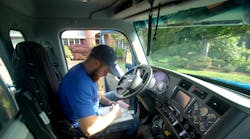How do you teach a driverless truck to fill out a paper log?
That was a question a 20–something passenger asked me as I gave him an Uber ride earlier this year in Portland, OR.
Our conversation started when I pointed out a custom-painted truck next to us. As we crawled in traffic across the Fremont Bridge, I showed him the Daimler Trucks North America headquarters building in the distance, and mentioned it is one of several companies developing autonomous trucks.
At that point he became really interested – a common reaction, regardless of age.
I shared my experiences with autonomous test drives, and he then asked about Uber rules, since he was thinking of becoming a driver himself.
Uber has no limit on driving hours, though on several occasions the app prompted me to take a photo to prove it was me in order to continue driving.
I then asked him how he thought truckers track their hours. He didn’t know how to respond – it seemed impossible after all this technology talk this was even a question.
I explained about paper logs and electronic devices, and how there was still a debate.
His response about teaching a driverless truck about paper logs was said somewhat sarcastically, and with some naivety. But it is not uncommon.
I brought up ELDs with Greg Reisnaur, owner of Elite Truck School. The former truck driver now trains driving students of all ages in Hillsboro, OR.
They all train on electronic logs. He suggested even those with past trucking experience would not choose a paper log, since so much of today’s trucks and our daily lives revolve around technology.
That brings me back to my Uber passenger. As he thought about ELDs, he correctly pointed out every single Uber driver and rider are being electronic monitored every trip.
That was electronic monitoring I was thankful for. It provided a level of security when picking up passengers, and safety if I was involved in a highway incident. It made it far easier to track the hours I was worked, and money I was making.
I was even thankful for electronic monitoring when I received a speeding ticket in the mail. It allowed me to dig into the data, and determine I was driving three generations of a family from a youth cheerleading competition to their downtown hotel. In fact, the real reason I got that ticket was lowered speed limits on the Morrison Bridge ahead of planned construction, and not because I was driving in a dangerous manner.
In recent days, Fleet Owner stories have singled out how the pace of technological change in trucking is accelerating, and the importance of leveraging technology to attract more talented professionals to the industry.
The idea of paper logs as we enter 2018 is in direct contradiction with those realities. That does not mean there are valid concerns surrounding the ELD mandate. However, much of the reaction to Fleet Owner’s coverage of ELDs have surrounded a lack of work flexibility.
That points to the Owner-Operator Independent Drivers Association and other ELD opponents being better off using electronic data to build the case for hours-of-service rule change and targeted ELD exemptions, rather than spending more time fighting for an increasingly outdated image problem.





